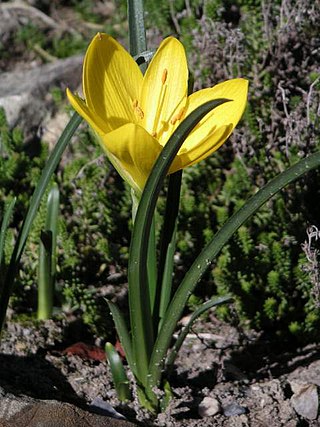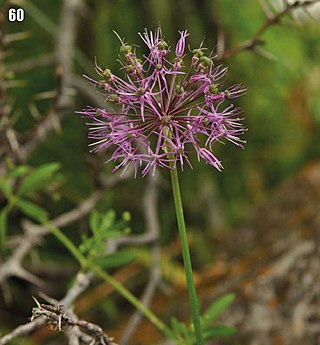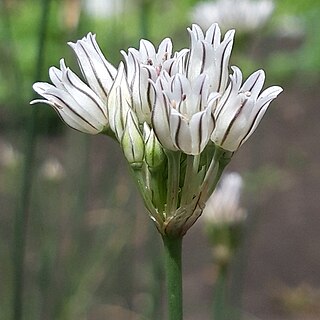
Colchicum is a genus of perennial flowering plants containing around 160 species which grow from bulb-like corms. It is a member of the botanical family Colchicaceae, and is native to West Asia, Europe, parts of the Mediterranean coast, down the East African coast to South Africa and the Western Cape. In this genus, the ovary of the flower is underground. As a consequence, the styles are extremely long in proportion, often more than 10 cm (4 in). All species in the genus are toxic.

Allium drummondii, also known as Drummond's onion, wild garlic and prairie onion, is a North American species of onion native to the southern Great Plains of North America. It is found in South Dakota, Kansas, Nebraska, Colorado, Oklahoma, Arkansas, Texas, New Mexico, and northeastern Mexico.

Allium giganteum, common name giant onion, is an Asian species of onion, native to central and southwestern Asia but cultivated in many countries as a flowering garden plant. It is the tallest species of Allium in common cultivation, growing to 1.5 metres (4.9 ft).

Sternbergia is a genus of Eurasian and North African plants in the Amaryllis family, subfamily Amaryllidoideae.

Pál Kitaibel was a Hungarian botanist and chemist.

Franz de Paula Adam Norbert Wenzel Ludwig Valentin von Waldstein was an Austrian soldier, explorer and naturalist.

Allium stipitatum, Persian shallot, is an Asian species of onion native to central and southwestern Asia.
Allium przewalskianum is an Asian species of wild onion in the Amaryllis family.

Allium karataviense is an Asian species of onion in the Amaryllis family. It is commonly known as Turkistan onion or ornamental onion.

Allium atrosanguineum is an Asian species of onion native to China, Siberia, Mongolia, and Central Asia. It grows high in the mountains at elevations of 2400–5400 m.

Allium fetisowii is a plant species native to Kazakhstan, Uzbekistan, Xinjiang, Kyrgyzstan and Tajikistan in Central Asia.
Allium flavovirens is a species of onions endemic to the western part of Inner Mongolia. It grows in dry places at altitudes of 1800–3100 m.

Allium korolkowii is a plant species native to Central Asia. It grows at elevations of 1500–2500 m.

Allium ledebourianum is an Asian species of wild onion native to central and northeastern Asia: Kazakhstan, Mongolia, Russia, and China. It occurs at elevations up to 1800 m elevation.

Allium macranthum is an Asian species of wild onion native to Bhutan, Sikkim, Gansu, Shaanxi, Sichuan and Tibet. It grows in wet places at elevations of 2700–4200 metres.

Allium mongolicum is an Asian species of wild onion native to Mongolia, Inner Mongolia, Tuva, Kazakhstan, and parts of China.
Allium schrenkii is an Asian species of wild onion native to Xinjiang, Kazakhstan, Mongolia and Siberia. It grows on steep slopes at elevations of 2400–2800 m.
Allium semenovii is an Asian species of wild onion native to Xinjiang, Kazakhstan, Tajikistan, and Kyrgyzstan. It grows at elevations of 2000–3000 m.
Allium filidens is a species of onion found at high elevations of central and south-central Asia. It is a bulb-forming perennial up to 45 cm tall, forming a hemispherical umbel of flowers; tepals white or pink with a purple midvein.

Sandy iris, or sand iris, is a species in the genus Iris; it is also in the subgenus of Iris and in the Psammiris section. It is a rhizomatous perennial, from Central Europe, found in Hungary, Austria, Romania, Czech Republic and Ukraine. It has grass-like leaves, a short stem and pale yellow flowers. It has had a mixed origin and was once Iris humilis subsp. arenaria, a subspecies of Iris humilis, until it was reclassified as a separate species. But many sources still state that it is either a synonym or subspecies of Iris humilis. It is cultivated as an ornamental plant in temperate regions.















